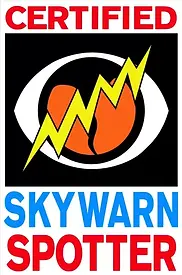
Winnebago County
SKYWARN
History of SKYWARN Spotters
SKYWARN spotters provide lifesaving information for all types of environmental hazards.
However, the main responsibility of a spotter is to report severe local storms.
More than 10,000 severe thunderstorms, 5,000 floods and 1,000 tornadoes occur in the U.S. during an average year. If that weren’t enough, spotters are also trained on warning signs for snowfall, earthquakes, landslides, avalanches, volcanic ash fall, and coastal hazards such as tsunamis, water spouts and rip currents. Since the program started in the 1960s, SKYWARN information, coupled with Doppler radar technology, improved satellite data and other resources, has enabled NWS to issue more timely and accurate warnings for tornadoes, severe thunderstorms and flash floods. SKYWARN storm spotters form the Nation’s first line of defense against severe weather. The efforts of these volunteers give communities the precious gift of time - seconds and minutes that can help save lives.


One way amateur radio operators give back is through SKYWARN, a program of the National Weather Service. SKYWARN volunteers are trained to watch the skies and report severe weather like tornadoes, hail, and flooding. During storms, local ham radio operators
relay these reports directly to the Weather Service, helping forecasters issue faster and
more accurate warnings.
Amateur radio operators also work side by side with:
ARES (Amateur Radio Emergency Services): Hams provide backup communications during
emergencies when phone lines, power, or internet fail. This ensures first responders and
local officials can stay connected.
Want to become a Storm Spotter?
Here are the steps:
1. Attend a storm spotter training class.
Classes are free, last about 2 hours, and are open to the public. We typically conduct our Storm Spotter classes virtually during the springtime (please see the schedule posted elsewhere on this website). Spotter training classes cover the basics of severe weather, including storm structure, feature identification, spotter positioning, safety, and severe weather communication. You can also take the class online on your own time by creating an account on this website and searching for "Spotter Training."
2. Find out about the local storm spotting network in your community.
If you are interested in becoming a Storm Spotter for your local community, contact your county emergency manager to learn more about local storm spotting efforts. You do not need to be affiliated with your community to be a Storm Spotter however; you can just as easily report severe weather as an independent spotter.
3. Retrain.
The NWS Chicago encourages spotters to go through the training at least once every three years to remain proficient.